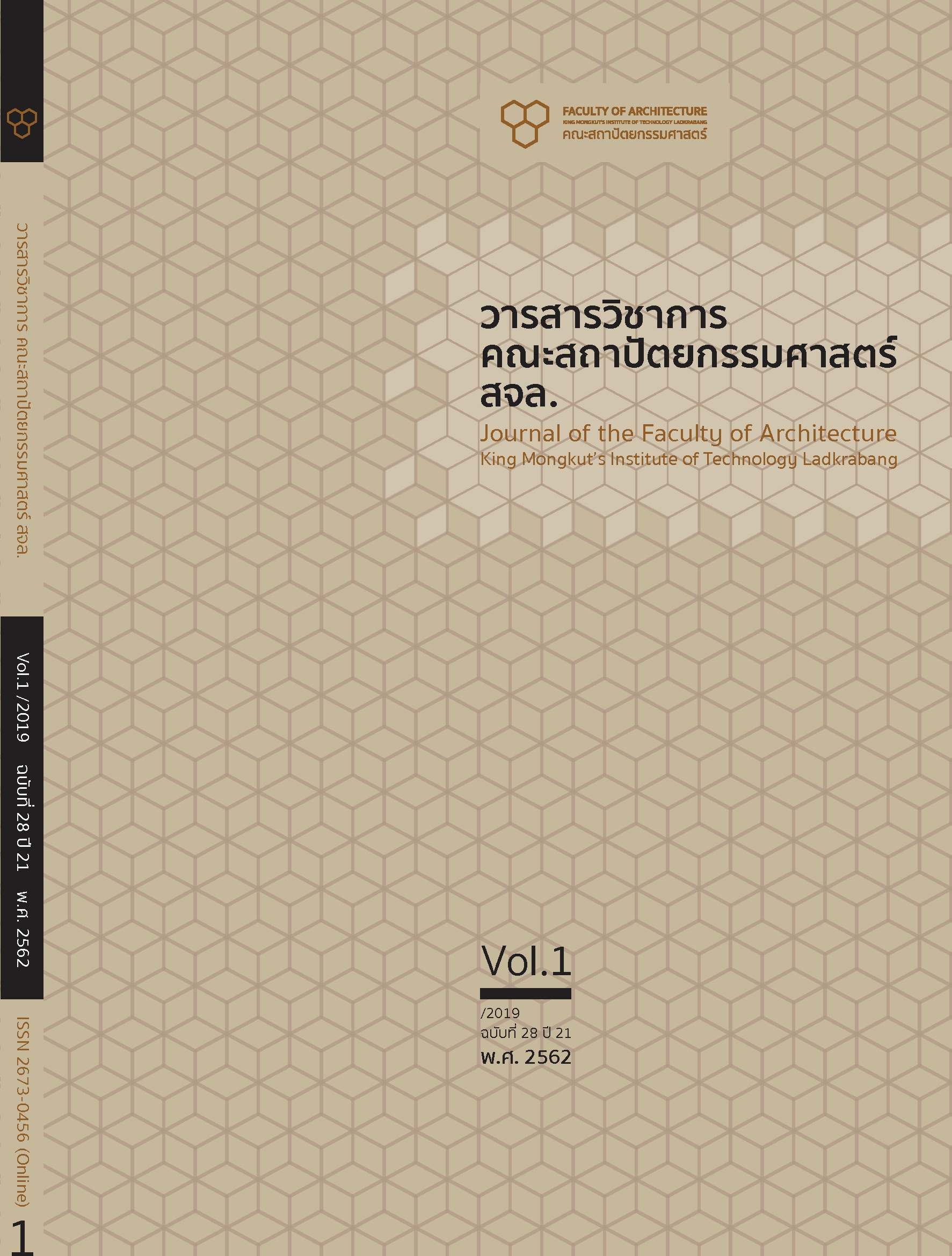The Guideline of Media Content Creation for the Environmental Conservation: Sea’s Still Blue
Main Article Content
Abstract
บทคัดย่อ
การวิจัยแนวทางการสร้างสรรค์เนื้อหาสื่อเพื่ออนุรักษ์สิ่งแวดล้อม: ยังคงสีคราม มีวัตถุประสงค์เพื่อ 1) รวบรวมข้อมูลปัญหาสิ่งแวดล้อมชายฝั่งของพื้นที่ กรณีศึกษา 2) แสวงหาแนวทางสร้างสรรค์เนื้อหาสื่อเพื่ออนุรักษ์สิ่งแวดล้อมด้วยการนำทฤษฎีทางสังคมศาสตร์มาปรับใช้ร่วมกับทฤษฎีภาพยนตร์ 3) สร้างสรรค์เนื้อหาและรูปแบบสื่ออนุรักษ์สิ่งแวดล้อมในรูปแบบบทภาพยนตร์ การวิจัยนี้เป็นการวิจัยเชิงคุณภาพ โดยอ้างอิงทฤษฎี และเก็บข้อมูลภาคสนามด้วยวิธีการสัมภาษณ์แบบเจาะจง คือ นายฐกร ค้าขายกิจธวัช หัวหน้ากลุ่มงานส่งเสริมและพัฒนาอาชีพประมง ศูนย์ศึกษาการพัฒนาอ่าวคุ้งกระเบน อันเนื่องมาจากพระราชดาริ และวิธีการสังเกตในการเก็บข้อมูลเหตุการณ์ ปรากฏการณ์ต่าง ๆ เพื่อให้เข้าใจในลักษณะธรรมชาติ และสภาพแวดล้อมชุมชน ตลอดจนปัจจัย ปัญหาต่าง ๆ ของพื้นที่กรณีศึกคือศูนย์ศึกษาการพัฒนาอ่าวคุ้งกระเบนอันเนื่องมาจากพระราชดาริ อ.ท่าใหม่ และชุมชนประมงพื้นบ้าน จังหวัดจันทบุรี
ผลการวิจัยพบว่าแนวทางในการสร้างสรรค์สื่อ เพื่ออนุรักษ์สิ่งแวดล้อมสามารถนำทฤษฎีหน้าที่นิยม ทฤษฎีการสร้างจิตสำนึกสาธารณะ และทฤษฎีการเล่าเรื่องมาใช้เป็นแนวทางในการสร้างสรรคด้วยการปรับใช้กับปัญหาของพื้นที่ได้ ซึ่งมิติทางหน้าที่นิยมคือหน้าที่หลักของสังคม 5 มิติที่ส่งผลต่อความมั่นคงของสังคม โดยเลือกใช้เพียง 3 มิติ เนื่องด้วยสอดคล้องกับปัญหาของพื้นที่กรณีศึกษามากที่สุด คือ มิติครอบครัว มิติเศรษฐกิจ และมิติศรัทธา มาปรับใช้ในการสร้างภาพตัวแทนผ่านตัวละคร และการใช้ทฤษฎีจิตสำนึกสาธารณะ 3 ระดับ คือ เห็นคุณค่า รับผิดชอบ อาสา มาใช้ในการแบ่งตอนของเรื่องออกเป็น 3 องค์ ตามระดับของการสร้างจิตสานึกสาธารณะผ่านพัฒนาการของตัวละครหลักและทฤษฎีการเล่าเรื่องในส่วนของการกำหนดเนื้อหาและอารมณ์ให้กับเรื่อง คือรูปร่างของเนื้อหา แก่นของเนื้อหา และรูปแบบของอารมณ์ แก่นของอารมณ์ มาใช้เป็นหลักการในการสร้างโครงสร้างของเรื่อง โดยหลักการและวิธีการวิจัยนี้สามารถนำมาปรับใช้เป็นแนวทางการสร้างสรรค์เนื้อหาสื่อเพื่ออนุรักษ์สิ่งแวดล้อมได้อย่างเหมาะสมตรงปัญหาของพื้นที่ และสะท้อนถึงบทบาทหน้าที่ของบุคคลในสังคม และสามารถกระตุ้นจิตสำนึกสาธารณะได้
คำสำคัญ: แนวทางการสร้างสรรค์ เนื้อหาสื่อ การอนุรักษ์สิ่งแวดล้อม
Abstract
The research of the guideline of media content creation for the environmental conservation: Sea’s Still Blue aims to 1) collect data regarding environmental problems of the coastal in the studied area, 2) explore the creative content guideline of media for environmental conservation by integrating the sociological theory and theory of cinematography, and 3) create the content and pattern of environmental conservation media on the movie. This research adopted the qualitative approach based on theories and collecting data by interviewing key informant selected by the purposive sampling method; Mr.Thakorn Khakaikitthawat Head of Fisheries Promotion and Career Development Group, Kung KraBaen Bay Royal Development Study Center. Observation was also adopted to collect the data about the occurrences and the phenomenon in order to understand the nature, the community, the environment, and the factors that cause those problems within this case study area; that is the Kung KraBaen Bay Royal Development Study Center, Tha Mai District and the local fishery community, Chanthaburi Province.
The result revealed that the structural functional theory, the public awareness theories, and the narrative theory can be used as the guideline to create media contents to solve environmental problems in the studied area. There were five dimensions in relation to the structural functional theory, three dimensions were considered and selected for developing contents of the story because they were relevant to current problems within the studied area. These three dimensions were 1) family dimension, 2) economic dimension, and 3) faith dimension, and these three dimensions were also adapted through characters of actors/actresses. The levels of theory of building public awareness were also applied, 1) appreciation, 2) responsibility, and 3) volunteering, to three chapters of the story, in accordance with sequences of building public awareness through main characters within the story. The narrative theory was adopted as the guideline to determine story contents and moods/tones in every scene, including the form of contents, substance of content, and form of the expression. It is expected that theories and methods adopted in this research can be adapted to create media contents that encourage people’s awareness to the environment conservation suitable for other areas.
Keywords: Creative Media Guideline, Media Content, Environmental Conservation
Article Details
This work is licensed under a Creative Commons Attribution-NonCommercial-ShareAlike 4.0 International License.
Copyright Transfer Statement
The copyright of this article is transferred to Journal of The Faculty of Architecture King Mongkut's Institute of Technology Ladkrabang with effect if and when the article is accepted for publication. The copyright transfer covers the exclusive right to reproduce and distribute the article, including reprints, translations, photographic reproductions, electronic form (offline, online) or any other reproductions of similar nature.
The author warrants that this contribution is original and that he/she has full power to make this grant. The author signs for and accepts responsibility for releasing this material on behalf of any and all co-authors.
References
กรมทรัพยากรทางทะเลและชายฝั่ง. (2561). สถานการณ์สัตว์ทะเลหายากไทย ปี 2560. เข้าถึงได้จาก https://www.dmcr.go.th
กาญจนา แก้วเทพ. (2552). การวิเคราะห์สื่อแนวคิดและเทคนิค. กรุงเทพฯ: ห้างหุ้นส่วนจำกัดการพิมพ์.
เกรียงศักดิ์ เจริญวงศ์ศักดิ์.(2543). โรงเรียนสร้างคนมีจิตสาธารณะ. วารสารการศึกษา 2000. 65(3), 17-25.
ฐกร ค้าขายกิจธวัช. (16 เมษายน 2560). สัมภาษณ์โดย แข มังกรวงษ์ . ปัญหาและแนวทางแก้ปัญหาสิ่งแวดล้อมทางทะเลของศูนย์ศึกษาการพัฒนาอ่าวคุ้งกระเบนอันเนื่องมาจากพระราชดำริ. สถานแสดงพันธุ์สัตว์น้ำเฉลิมพระเกียรติ 6 รอบพระชนมพรรษา อ่าวคุ้งกระเบน
นพดล อินทร์จันทร์. (2554). ภาพยนตร์ไทย : พัฒนาการความคิดด้านศิลปวัฒนธรรมในสังคมไทย. วารสารสถาบันวัฒนธรรมและศิลปะ. 3(1), 31-35.
พิสุทธิ์ เพียรมนกุล.(2556). บทความภาพรวมแนวทางจัดการน้ำมันรั่วไหล (Oil Spill) ลงสู่ทะเล. เข้าถึงได้จาก https://www.eng.chula.ac.th
พิสุทธิ์ เพียรมนกุล และรัฐพล เจียวิริยะบุญญา. (2560).การอนุรักษ์และการใช้ประโยชน์จากมหาสมุทร ทะเล และทรัพยากรทางทะเลอย่างยั่งยืน. เข้าถึงได้จาก https://mbamagazine.net.
ไพบูลย์ เติมสมเกตุ และบุญเอื้อ บุญฤทธิ์ ทินพันธุ์ นาคะตะ. (2560). การอนุรักษ์สิ่งแวดล้อมชายฝั่งอ่าวไทย: กรณีศึกษาจังหวัดระยอง และจังหวัดจันทบุรี. วารสารเกษมบัณฑิต. 18 (1), 97-105.
ลอรา ปาร์กเกอร์. (2561). วิกฤตพลาสติก. นิตยสารเนชั่นแนลจีโอกราฟฟิก,ฉบับภาษาไทย.เล่มที่ 203 เดือน มิถุนายน. กรุงเทพฯ: สำนักพิมพ์อมรินทร์พริ้นติ้งแอนด์พับลิชชิ่ง.
ศศิน เฉลิมลาภ. (2560). บทความในหลวงรัชกาลที่ 9 กับการอนุรักษ์. เข้าถึงได้จาก https://www.seub.or.th.
สงคราม เชาวน์ศิลป์. (2535). จิตวิทยาทั่วไป. เชียงใหม่ : มหาวิทยาลัยเชียงใหม่.
สมาน งามสนิท. (2539). เอกสารการสอนชุดวิชาความรู้เบื้องต้นเกี่ยวกับภาพนิ่งและภาพยนตร์. หน่วยที่ 10. พิมพ์ครั้งที่ 8. กรุงเทพฯ: มหาวิทยาลัยสุโขทัยธรรมาธิราช.
ส่วนแผนงาน สำนักงานอธิการบดี. (2554). แผนกลยุทธ์สถาบันเทคโนโลยีพระจอมเกล้าเจ้าคุณทหารลาดกระบัง (พ.ศ. 2555 - 2563). (หน้า 22-25).กรุงเทพฯ: สถาบันเทคโนโลยีพระจอมเกล้าเจ้าคุณทหารลาดกระบัง.
องอาจ สิงห์ลำพอง. (2557). กระบวนการผลิตโทรทัศน์. กรุงเทพฯ: ห้างหุ้นส่วนจำกัดสามลดา.
เฮเลน บริกส์. (2561).บทความผลสำรวจชี้ 1 ใน 3 ของแนวปะการัง มีพลาสติกติดอยู่. เข้าถึงได้จาก https://www.bbc.com/thai/international.
Robert Lapsley and Michael Westlake.(1992). Film Theory: An Introduction.UK: Manchester Univ Pr.


